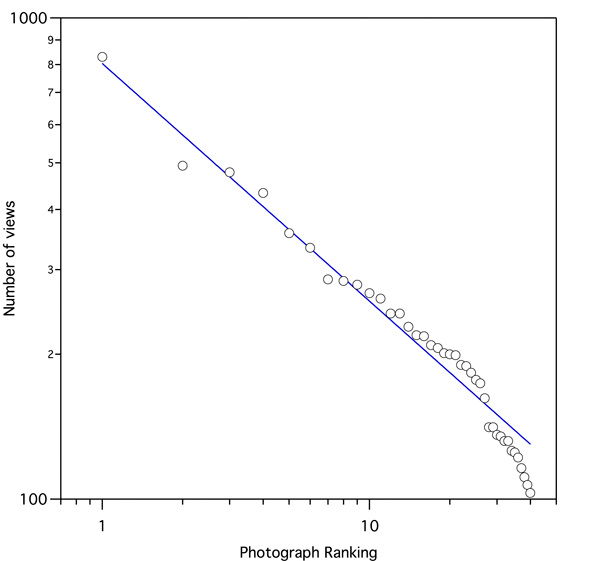In science, one of the recent trends is to characterize people's careers by looking not just at number of citations and such but at what's called the
Hirsch-index. The number indicates how many papers you have published that have received at least the same number of citations. So, if you have an h-number (that's where I am now) of 17, you have 17 peer-review publications that have been cited at least 17 times. The existence of this number comes from the observation that if you rank publications according to their number of times cited, you get a power-law series and the h-number basically is it's moment. Now, where does photography come in you ask? I just had an interesting observation in looking at the number of page-views my images get on flickr. If you rank them in a similar way, according to the number of image-views, it turns out that my stream has a very similar power-law behavior:

This is a powerlaw with an approximate power of -1/2. It looks remarkably similar to the distribution I get when plotting the number of citations to my scientific papers. In fact, many social phenomena are known to be distributed in a similar power-law fashion. A good example (from Murray Gell-Mann's famous book on chaos theory, the Quark and the Jaguar BTW) is the distribution of populations in US cities.
If for my flickr stream, you do the same analysis on this distribution as the h-number (on flickr you just
go through your most popular sorted by views pages until you find the one where the number of views equals the ranking number) I get a f-index (instead of h-index) of 65! This is the turning point image:

What's your f-index?



While I'm still not certain of the value of the f-number, ie, is higher better (I think you imply it is...), mine is 182 currently...
ReplyDeletehttp://www.flickr.com/photos/seanmcfoto/popular-views/page10
It's a crap photo, but so what!
Haha, yeah higher is better. In science, the h-index I refer to is widely used to judge a scientist's career. It judges the value and depth of your work. You could make the same argument for your f-index I guess. The index also should grow steadily as you produce more, high quality, work. Of course you need to make the not totally justified assumption that flickr pageviews are related to quality.
ReplyDeleteI have reached inipendently your same results and added some more considerations relating what I called
ReplyDeleteHFV (hirsch factor of views)
and the most viewew image
check this link
http://www.flickr.com/photos/ardiglione/2414984683/
Pietro Armienti